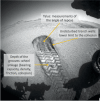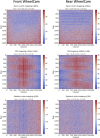The WheelCams on the IDEFIX rover
- PMID: 40672784
- PMCID: PMC12259770
- DOI: 10.1186/s40645-025-00725-3
The WheelCams on the IDEFIX rover
Abstract
IDEFIX, the Martian Moons eXploration (MMX) mission Phobos rover, will be the first of its kind to attempt wheeled-locomotion on a low-gravity surface. The IDEFIX WheelCams, two cameras placed on the underside of the rover looking at the rover wheels, provide a unique opportunity to study the surface properties of Phobos, regolith behaviour on small-bodies and rover mobility in low-gravity. The information gained about Phobos' surface will be of high importance to the landing and sampling operations of the main MMX spacecraft, in addition to being valuable for understanding the surface processes and geological history of Phobos. Here we introduce the WheelCam science objectives, the instrument and the characterisation activities. We also discuss the on-going preparations linked to the analysis and interpretation of the WheelCam images on the surface of Phobos.
Keywords: Camera; Geotechnics; In situ imaging; Locomotion; MMX; Morphology; Phobos; Regolith; Space weathering; Terramechanics.
© The Author(s) 2025.
Conflict of interest statement
Competing interestsThe authors declare that they have no competing interest.
Figures





















References
-
- Agarwal S, Senatore C, Zhang T, Kingsbury M, Iagnemma K, Goldman DI, Kamrin K (2019) Modeling of the interaction of rigid wheels with dry granular media. J Terramech 85:1–14
-
- Amsili A et al (2025) 3d reconstruction of local topography using the IDEFIX WheelCams. 2025 (in preparation)
-
- Arvidson RE, Anderson RC, Haldemann AFC, Landis GA, Li R, Lindemann RA, Matijevic JR, Morris RV, Richter L, Squyres SW, Sullivan RJ, Snider NO (2003) Physical properties and localization investigations associated with the 2003 Mars Exploration rovers. J Geophys Res: Planets 108(E12):2002JE002041. ISSN 0148-0227. 10.1029/2002JE002041
-
- Asnani V, Delap D, Creager C (2009) The development of wheels for the lunar roving vehicle. J Terrramech 46(3):89–103
-
- Attree N, Groussin O, Jorda L, Sergey Rodionov A-T, Auger NT, Brouet Y, Poch O, Kührt E, Knapmeyer M et al (2018) Thermal fracturing on comets-applications to 67p/churyumov-gerasimenko. Astron Astrophys 610:A76
LinkOut - more resources
Full Text Sources
